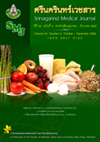Iron Deficiency Anemia and Energy and Nutrients Intake of Vegetarian Adolescents in Ratchatani Asoke Community, Ubon Ratchathani Province
Abstract
Background and Objective : Iron deficiency anemia is an important public health problem especially among children and adolescents who are still growing and developing. This cross-sectional study aimed to determine the prevalence of iron deficiency anemia, energy and nutrients intake among vegetarian adolescents.
Methods : Ninety four vegetarian adolescents (51 males, 43 females) living in the Ratchatani Asoke community, Ubon Ratchathani Province aged between 10 to 19 years participated in this study. All adolescents were screened for thalassemia by OF and DCIP. Anemia was defined as Hb values lower than the WHO standard. Iron deficiency anemia (IDA) was defined as serum ferritin (SF) <15µg/l concurrent with anemia. Iron depletion (ID) was defined as SF lower than 15µg/l with non anemia. Nutritional intake was calculated from 7 day dietary food records of 86 adolescents. Energy and nutrients’ adolescents were analysed by comparing with Thai recommended dietary allowance (RDA). The data were collected from February to April 2009.
Results : The median duration of consuming vegetarian diet of the respondents was 3 years (Q1- Q3=2-5). Most of then (89.5%) skipped lunch. The prevalence of anemia among vegetarian adolescents was high at 42.6%, with a similar proportion found for males (43.1%) and females (41.9%). The prevalence of IDA, was 24.5%, with higher proportion among females (30.2%) in comparison to males (19.6%). The prevalence of ID was 18.1%, with 15.7% for males and 20.9% for females. The median amount of energy and protein intake were 50.9% (Q1-Q3= 40.3-61.2) and 49.7% (Q1-Q3= 39.1-59.2) of RDA, respectively. The median amount of iron intake was only 34.4% (Q1-Q3=23.9-48.7) of RDA and the median vitamin C intake was 72.5% (Q1-Q3 = 50.5-108.8) of RDA. Energy intakes expressed as a percentage of total energy of carbohydrates was found to be 67.4%, 11.1% of protein and 21.5% of fat.
Conclusion : The prevalence of IDA and ID among the vegetarian adolescents was high. Special attention in this respect must be given among female adolescents. The ways and means must be found to correct the situation, in advocating diets with high iron content and also iron supplementation might be considered.
Keyword : Iron Deficiency Anemia, Iron Depletion, Vegetarian, Adolescents




